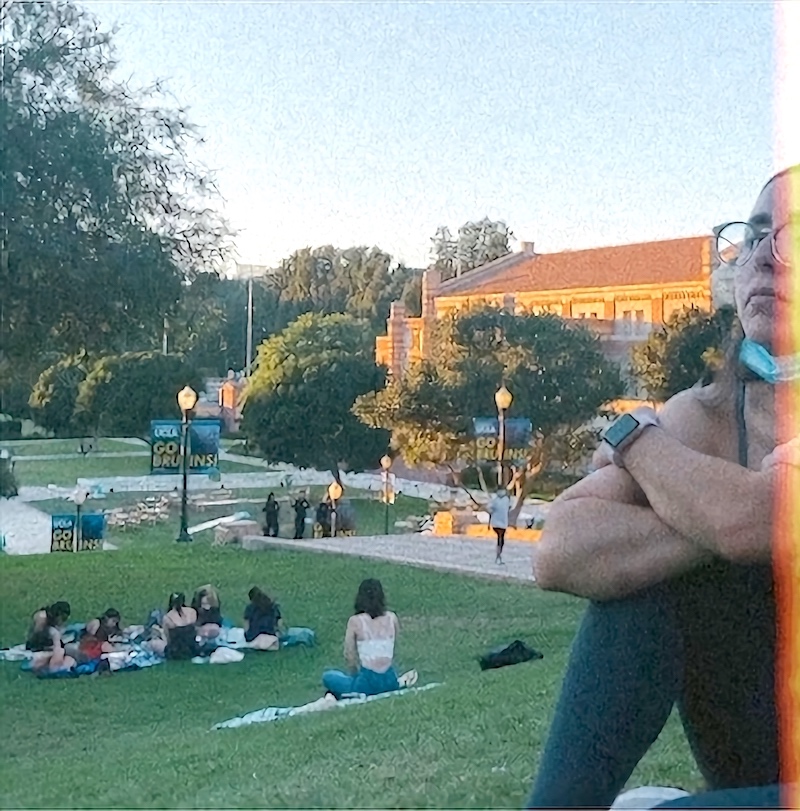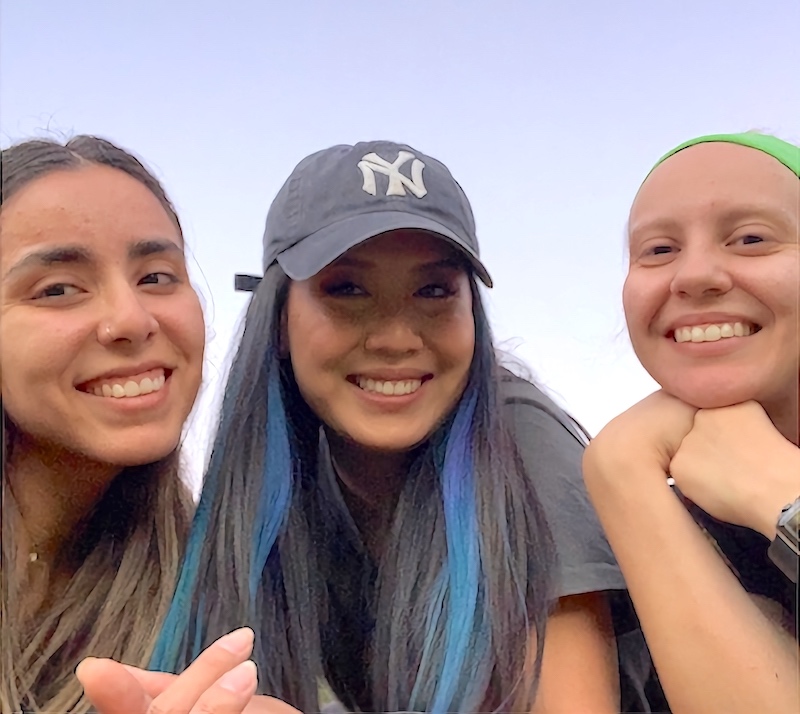Student Blog
Diversity
My Experience in Creating the World OT Day Video for the USC Chan Division ⟩
November 29, 2021, by Global Initiatives Team
Diversity International Videos What are OS/OT?
By Kashvi Shah, Post-Professional Master’s student
Editors Michelle Plevack and Abraham Ramirez
Entry-Level Professional Master’s students
“Our sense of belonging can never be greater than our level of self-acceptance.” — Brené Brown.
At USC Chan, we have a diverse global community with a significant percentage of international students. Most of them struggle to find their sense of belonging in this new environment and find it challenging to develop resilience. However, “true belonging does not require you to change who you are: it requires you to be who you are” (Brené Brown).
Hence, on this World OT Day, I thought it would be a great idea to involve our student community in celebrating ourselves and our profession. I approached Dr. Daniel Park at the Global Initiatives office with the idea of creating a short video film of our students on the theme by WFOT (World Federation of Occupational Therapists): Belong, Be You. I am sure you began to wonder what these words mean to you. And so did I.
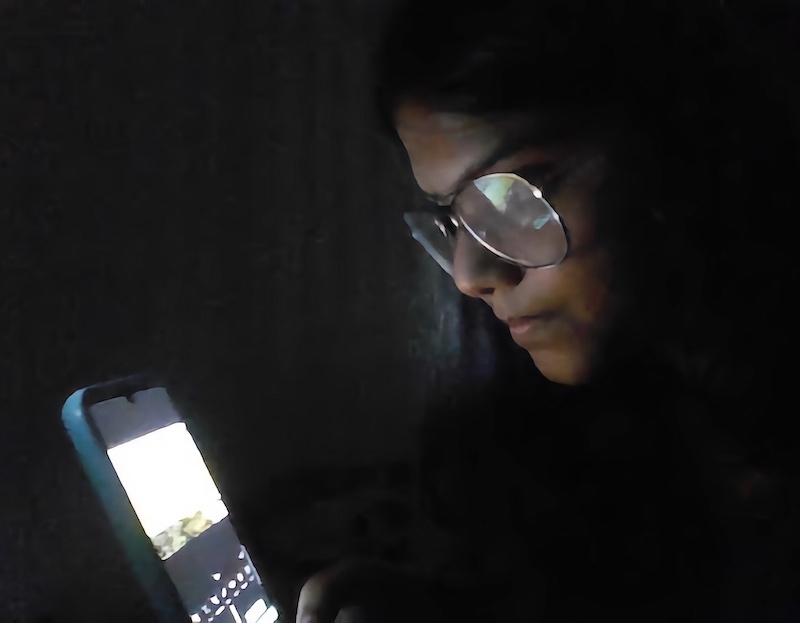
Kashvi in the process of World OT Day video editing
Earlier, I was excited about this project as I found an opportunity to contribute to this with my interest in videography and editing. However, soon after my excitement turned into anxiety. The technical aspects of videography then seemed less challenging than the conceptualization of this video, which was more entangled than expected.
Fortunately, I had the assistance of Marvyn Ngo, our MA-1 Student Ambassador at USC Chan, who always corroborated my ideas and furthermore, helped in reaching out to students for participation in the video.
The most exciting and enthralling part of this process began next, as it was finally time to put together what the participants had shared. Ann Beattie once said “People forget years and remember moments.” That is exactly what the video clips from our participants’ cherished moments were. They could feel their belonging in celebrating who they really are! I enjoy dancing as a meaningful occupation wholeheartedly and being myself is my true belonging. I was glad to see how all our participants found meaning in different activities.
For me this experience was so enriching. From facing the challenges of generating ideas to the support in executing them, and from the excitement of creation to the anxiety of outcome, it was indeed a whirlwind. For this opportunity, I am grateful to those at the Chan Division who added meaning to my belonging at USC.

Kashvi enjoying dance, Being herself!
References
Brown, B. (2012). Daring greatly: How the courage to be vulnerable transforms the way we live, love, parent, and lead. New York, NY: Avery.
Brown, B. (2017). Braving the wilderness: The quest for true belonging and the courage to stand alone. New York, NY: Random House.
Beattie, A. (2002). Where you’ll find me and other stories. New York, NY: Scribner.
⋯

From Inside of Your Mind to Outside of Your Closet: Making a Case for Dressing ⟩
November 22, 2021, by Seth
Diversity What are OS/OT?
We all know that a good dressing can make or break a salad, but what can it do for your day? No, I’m not talking about dousing yourself in ranch, Italian, or even a tasteful balsamic vinaigrette, this blog is about clothes! The American Occupational Therapy Association’s Occupational Therapy Practice Framework (OTPF): Domain and Process (4th ed.; 2020) defines dressing as:
Selecting clothing and accessories with consideration of time of day, weather, and desired presentation; obtaining clothing from storage area; dressing and undressing in a sequential fashion; fastening and adjusting clothing and shoes; applying and removing personal devices, prosthetic devices, or splints. (p. 30)
When I am asked about dressing, however, I simply define it as one of my favourite occupations.
We all know the basics: is it hot outside? Put on a t-shirt. Is it time for bed? Time for pajamas! Do you have an interview later today? Gotta wow them with your best business casual. Some people may find these decisions a chore, as something that takes up those precious moments in the morning that you could instead use to snooze your alarm. It could even be that you may be one of these people, but I often think that there are a lot of missed opportunities when it comes to dressing and I’m here to push the envelope. Although AOTA’s definition is dynamic, two parts stand out, two parts that open the door for this conversation, and those are “consideration” and “desired presentation.”
The Black
I have to admit that it took me some time to understand the nuances of what “desired presentation” really meant. To set the scene for you, I want to take you on my personal journey with the occupation of dressing. If a stranger looked at me in high school, they would probably describe my sense of style as “prep.” Without fail you could spot me in a neutral or plaid button-up shirt with sleeves cuffed to the forearm over a standard pair of khakis. I woke up every morning, donned a variation of this outfit, and walked out the door without a second thought. When I look back at that time, however, I think that by dressing in preppy I was actually prepping for a day that I thought would change everything; the day I came out as gay. I thought that if I made the way I looked more palatable and if I blended in more that when the day came, people wouldn’t be so quick to reject me. That they’d at least think twice about it. It turns out that every seemingly unconscious dressing decision I made considered that outcome and I so desperately wanted it to not be the case.
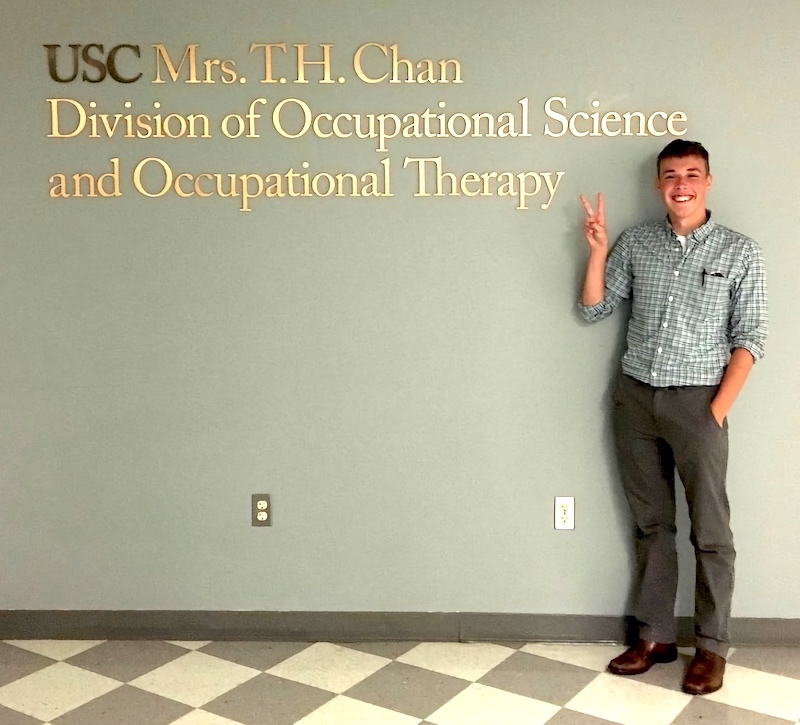
High School Seth before the first week of classes at USC in August 2017, AKA photographic evidence of the aforementioned button-up, cuffed sleeves, and khakis.
The White
Things began to change my senior year when I realized that that time in my life was coming to an end. Graduation was on the horizon and I began to loosen my collar, wear some jeans every once in a while, and add some colour into the rotation. Then came the news that I was admitted to USC’s BS-MA program and, although it was months before the semester started, my mind was already in LA. What was I thinking about? That a new place meant a new me, and even more importantly, a new wardrobe. I started to go thrifting and over time, with the support of my lovely community, I decided to let the world know I was capital G-A-Y, GAY! When I got dressed in the morning, this was the desired presentation I coordinated everything around. USC just had to know. Talk about a complete 180°.

First-Year Seth at his first LA Pride, June 2018. To this day, I stand by this outfit.
And All the Colours In-Between
As the years have passed, and as I’ve grown with my intersectional identities, the way I dress has grown with me and now lies somewhere in the middle of that spectrum. I think the single-driving force that informs how I dress is not what I want for others to see, but what I want for myself. On a cloudy day, I’ll bring my own sunshine by wearing my brightest outfit. As the leaves start to change colours, I’ll camouflage myself to match.

Me this semester, November 2021, comfy and coordinated down to a lavender mask.
I’ve found that weather and time can only change so much, but what I feel when I wake up in the morning is always something new. It’s this uncertainty that makes dressing exciting to me. It’s how one day a shirt can convey one message, but the next day when paired with a different pair of pants it says something totally different. Although what I consider may seem to be more considerate of myself, I want to highlight, however, that High School Seth was just as authentic as First-Year Seth who is just as authentic as the Seth I present to the world now. The one thing that they all have in common, and the thing we all have in common regardless of our identities, is that in each stage there was an intention for a specific desired outcome. Although this blog shares my story, it by no means is meant to capture anyone else’s. That being said, we all get dressed and we all make decisions while doing so. I invite you to take a closer look at the dressing decisions you make, and who knows, you may even help a client do the same in your future practice! Here are some questions to help guide you as you embark the journey to making dressing one of your favourite occupations too:
- What is your intention for the day and what ways do you desire being perceived? How can you align the two?
- Do the clothes you chose match how you feel? Or do they reflect how you want to feel? How does the way you dress support your social and emotional health? Think style with a side of self-fulfilling prophecy!
- How does dressing interact with other occupations? Does it influence your social participation? What’s its relationship with hygiene and grooming occupations?
- I shared how I use dressing to express my identities, do you use dressing to express yours? If yes, which and how?
- Who says dressing can’t be leisure or play! If today was a costume party, what theme would you dress for?
And lastly, it’s a new day, what do you want to put out into the world?
⋯
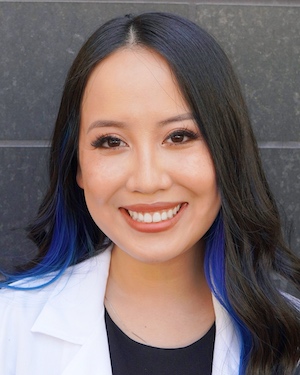
Fight, Fight, Fight On! ⟩
November 19, 2021, by Teresa
Admissions Classes Diversity Living in LA
Tomorrow is the big game and with it comes the long-standing question of Los Angeles: “USC or UCLA?” Forget sideline reporters, say goodbye to sports commentators, play-by-play who? I believe I am the most qualified individual to provide an answer for these reasons:
- I went to UCLA
- I go to USC
- Refer back to reasons 1 and 2
All jokes aside, when I committed to USC for graduate school, I had some concerns about how I would transition from the nation’s #1 public university into the #1 occupational therapy program. Without further ado, here is one Brojan (Bruin turned Trojan, or vice versa)’s totally impartial, and absolutely not at all biased, take on my experiences at both schools.
Quarter System vs. Semester System
At UCLA, we followed a quarter system, meaning each term was 10 weeks long, three terms each academic year. Because of how fast-paced this was, I thought a semester system would be an easy adjustment but sometimes, it still feels like my mind functions on 10 weeks’ time. Kind of like when you return from traveling somewhere really far and have to readjust to the time difference. Yeah — just like that, but for a much longer period of time. For example, I am currently entering week 14 out of 16 and my mind is saying to the semester, “You’re done. You’re done. You should be three weeks into the next term already.” Because 16 weeks and NOT 10? The math is just not mathing for me. What does make sense for me, however, is how nice it feels to have time to sit with content, follow up about anything I need clarification on, and really feel like I’m learning and not just regurgitating. And it doesn’t hurt that with the longer terms come longer breaks!
Public University vs. Private University
Growing up, the words “private school” sounded so elite and since public school was all I had known, attending a public university like UCLA after high school felt like the natural progression, so I didn’t even bother applying to USC.

Sophomore me visiting the USC Bookstore on a high school field trip in May 2012. The irony is not lost on me that I now have the sweater in the background, which I am currently wearing while writing this.
When applying to OT school, a part of me still held the notion that private = elite and public = diversity, but that myth was quickly dispelled when I met my classmates, who are each so different and unique in their backgrounds, life perspectives, age, appearance, and interests, thanks to the holistic admissions process implemented at USC Chan. The insights shared by my classmates both in and out of the classroom have been quintessential to facilitate my learning as I continue to develop my clinical identity. I feel an immense sense of pride knowing that my classmates will be entering practice as some of the most culturally responsive clinicians this field has to offer and that their clients and future generations will be able to see themselves in their providers.
My family always emphasized that education is an investment to give myself the best chance at life, so when deciding which program to attend, what better is there than the best? I could think of no better place to invest in myself than at USC Chan, which, in case you forgot, is the #1 occupational therapy program in the nation, and it shows. It’s pretty surreal to walk the halls of the Center for Health Professions (CHP) and know that it’s the birthplace of sensory integration, occupational science, Lifestyle Redesign, and so much more. Occupational therapy students all over the world are learning through textbooks written by the same professors you get to see face-to-face everyday. Since starting this program, it’s been clear that our faculty, staff, ambassadors, student leaders, and alumni are committed to fostering a space where the next generation of occupational therapists can both advocate for our profession while challenging it to change to meet client needs.
Undergraduate Degree vs. Graduate Degree
The pursuit of my undergraduate degree was filled with twists and turns regarding what career I wanted that degree to lead to — pediatrician, lawyer, software engineer, teacher, and at one point, even paleontologist! I am always amazed (and slightly jealous) when I hear Bachelor’s to Master’s students share why they chose to pursue OT when they were a senior in high school, because I didn’t know about OT until I was 20. While I don’t regret my journey because it’s what led me here today, I will say school was so much harder when I didn’t know what I was meant to do. It was also so much harder when I couldn’t imagine myself ever using organic chemistry or multivariable calculus in my career, yet still had to take those classes in order to get my degree. To this day, the fact that I know how to draw molecular structures using benzene rings or chair conformations has not served me. Not once!
Entering graduate school provided an opportunity for a clean slate. I was able to start over as a student at a new school but this time, as a student with a strong understanding of what I wanted while taking courses focused on what I was interested in. By acknowledging that all of the content I learn in the classroom could be applied to practice, being a student has become a more engaging and meaningful experience.
So, USC or UCLA?
This question is hard to answer because ultimately, I am so thankful to both. My experiences at UCLA led me here to USC, where I find myself growing professionally and personally everyday. Both allowed me to be close to home and near my family, who I wouldn’t be here without. At one, I was able to identify my weaknesses and at the other, take a strengths-based approach. This past weekend, I showed my friends Silvia and Vanessa around UCLA, where we sat next to Janss Steps and talked for hours.
While walking the same paths I used to take to class, I remembered how I felt there when the thought of becoming an occupational therapist seemed like a distant, unattainable dream because I couldn’t see past who I was on paper — just another GPA, GRE score, and 1000 words. And becoming a USC Chan occupational therapist? Dream on.
Look at you now. Fight, fight, fight on. 💙 🐻 💛 ✌️ ❤️
⋯
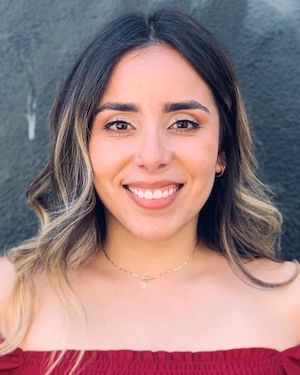
La Primera, Pero No La Ultima ⟩
November 9, 2021, by Silvia
Diversity First-Gen
To my sisters and to the siblings of other first-generation students: you belong here. We may be the firsts, but we won’t be the lasts.
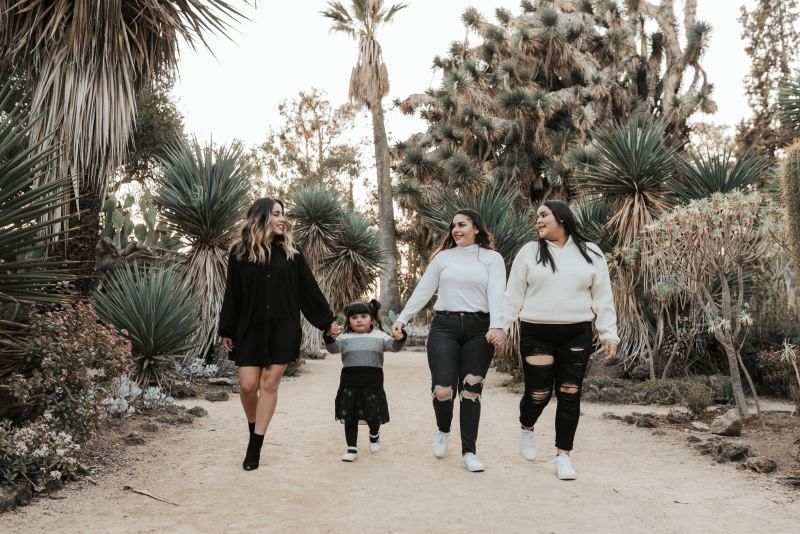
Hermanas, I will hold your hands every step of the way — Photo by: fatimajphotography
“Everybody looks rich and smart” — An observation of the USC Village made by my sister.
Sis — do I look rich to you? Maybe a little smart, but rich? Talk about a “she doesn’t even go here” moment. I think about this moment a lot because reading between the lines it means that she can’t fully believe that I do go here, and even more upsetting, I don’t think she sees the possibility of herself going here either. This speaks to feeling like you don’t belong in certain spaces because when you look around, there isn’t many, if any, people who look like you. Though her description may not encapsulate everyone who goes to USC, her feelings and thoughts are valid. I, along with many other first-generation students, have felt this way throughout our collegiate journey.
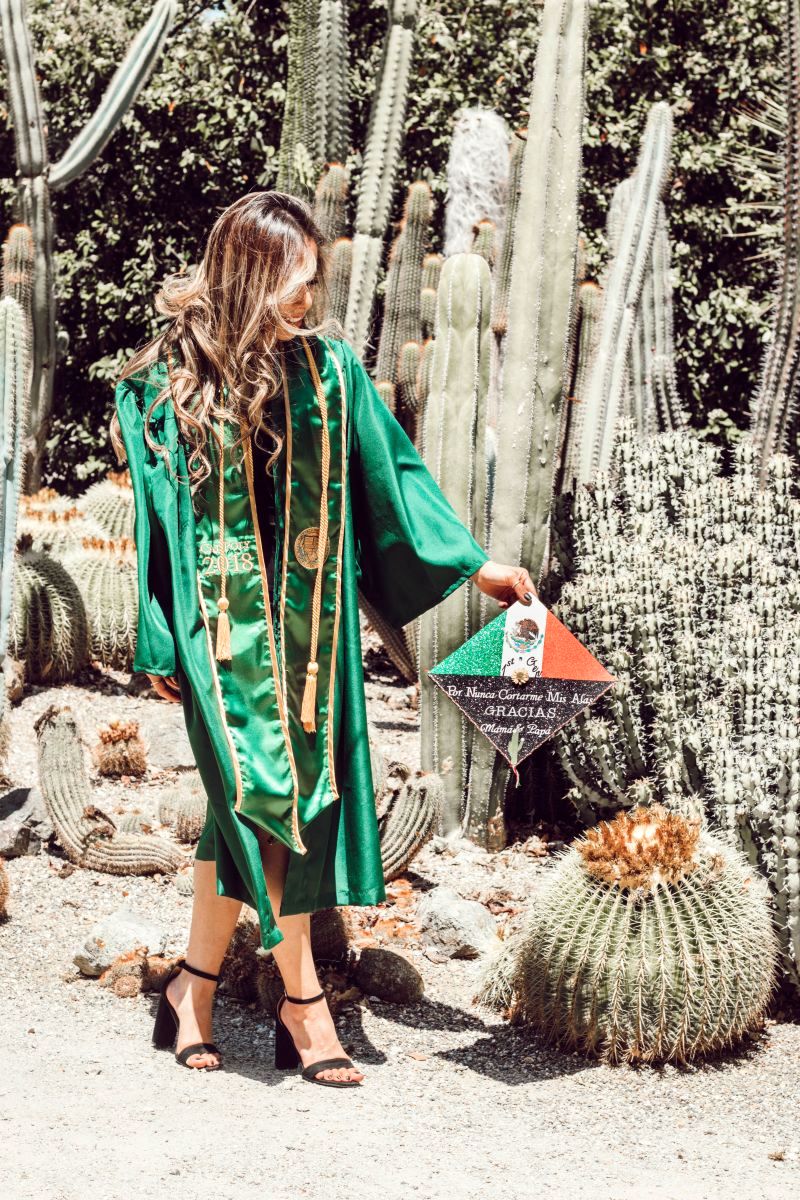
Graduating Undergrad as 1st Gen — Photo by: Madison Noelle Photos
When I tell you that immigrant, three-year-old, non-English speaking me could have never imagined being here today — finishing my master’s degree at the top OT program — I mean it. Growing up, college was never a topic of conversation in my house, yet education was always emphasized to be the key for a better future. Getting good grades was expected and not something to be rewarded for — the one time I asked my mom if I could get an allowance for having straight As she was quick to say “. . . mira mira, ya parece que te voy a dar dinero por hacer tu trabajo en la escuela . . . esa es tu responsabilidad.” Being a good student was my responsibility and something I took great pride in. Subconsciously, it was also something I held onto with the hopes of getting into a “good” college one day.
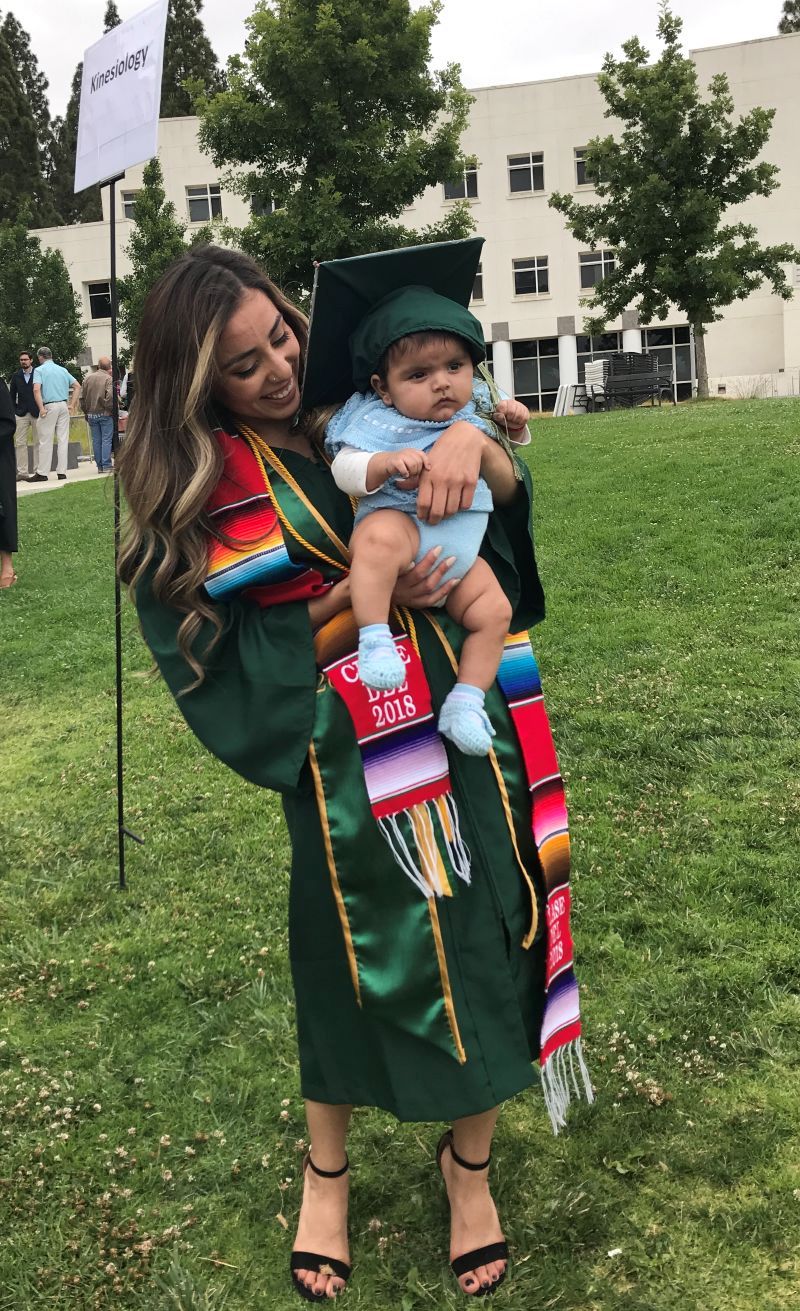
Baby Meeks and I at our undergrad graduation

3 year-old Meeks and I celebrating the end of the summer semester
Going to college is such a romanticized notion though . . . from choosing your dream school, to moving away from home, living in a dorm, meeting the people who will become your lifelong best friends, and everything else that you daydream about until reality hits. How do you get to live all these experiences when you don’t even know the name of any universities (besides the ones stamped onto the sweaters your classmates wore), when you don’t know how/where to apply, when you’re poor and probably can’t even afford to live these experiences? I remember asking my dad if he had a savings account because, if I decided to go, college would be really expensive. He didn’t give me a clear answer but assured me that if I wanted to go to school, we would make it happen. In his words, “Hay mucho sacrificio que se tiene que hacer, pero independientemente de eso, [mientras que tenga el apoyo de todos, yo puedo] salir adelante.” Needless to say, pursuing higher education has been a very tiring journey.
It’s almost like being completely lost in the application process and scared that somehow you incorrectly inputted something in your FAFSA is a rite of passage for first-generation students. And I know for a fact that this isn’t true for all college students because I can name some of my high school peers whose parents did everything for them — but that’s besides the fact and my point is simply that we’re not all on an equal playing field. Being first-gen means figuring it out on your own and paving the way for those who will follow after you. Though this is rewarding, it is exhausting.
No one really talks about the culture shock that you may experience, the impostor syndrome, the burnout, the guilt, and all the other not-so-good things that come with college and that are compounded by being first-gen. Fully unpacking what it means to be first-generation, however, cannot be done in one blog, so stay tuned for the sequel. But I don’t want to end this blog without acknowledging that in the process of chasing and living out this dream of being the firsts in our families to go to college, we often lose sight of who we are and what we want. We carry the hopes, dreams, and sacrifices of our parents and families, which fuel our academic drive but also hold us back from other things we want to do with our life. So, I encourage you to check-in with yourself; what do you want?
⋯
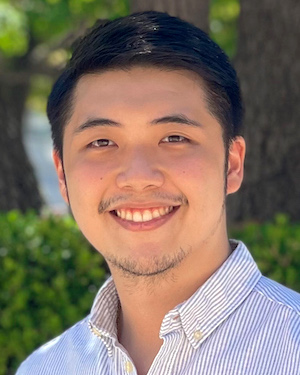
My Class is a Nexus Point ⟩
September 29, 2021, by Marvyn
Diversity International Living in LA
A nexus is a connection of multiple links into a common point or place. In the Post-Professional Master’s program, it’s just that.
If you read about my previous blog post (OT was not my first choice . . . but I have no regrets), I mentioned that time and destiny have their unique way of bringing people together. The program I’m in is no exception to this. For the most part, it’s almost serendipitous. Can you imagine that more than 30 unique individuals, having each their own personal experiences and life stories across the globe, flew into Los Angeles to study OT? On top of that, we’re still in the middle of a global pandemic!! It sounds so crazy and thrilling to me that I have classmates from India, Taiwan, Hong Kong, South Korea, Singapore, Colombia, the Middle East, and of course my home country the Philippines. Being at class in person, it’s essentially a melting pot of unique stories and personalities: flavors from all around the world! It still baffles me that despite all the circumstances we were all dealing with individually, life just situates us to be together in a class to learn and grow from each other.
You see, experiencing LA is one amazing thing. But can you imagine exploring it with a class that’s as diverse as this? Check out this hike we did at the Eaton Canyon we did on our second week of class! Some say the trail is pretty basic, but it’s much less about the hike but more about the company you’re with. And if you’re hiking with this bunch, you will always run out of breath from having endless, great conversations (oh, and from hiking too of course).
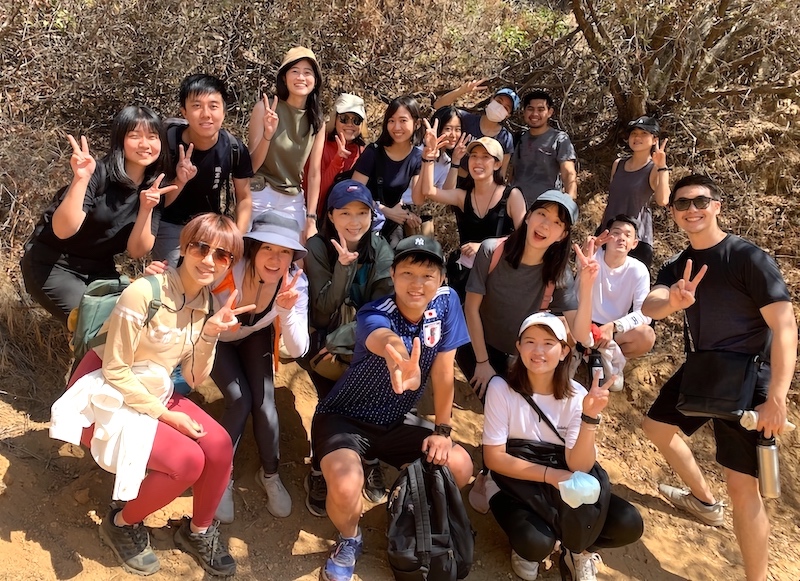
The PP-MA class on our first hiking trip in Eaton Canyon! Photo credits to Yu-Hsuan (Florence) Yang.
On top of that, Dr. Danny Park along with the Global Initiatives team has been very hands-on in support of International Students at Chan, like us in our class. We had events like social mixers and support groups to emphasize togetherness in a culturally diverse environment. A chance to meet and learn from somebody else’s stories and experiences are really irreplaceable, and they are doing an amazing job at that. Fun fact: Did you know that Mooncakes symbolize togetherness and prosperity? Look at some of my classmates celebrating the Mid-Autumn (Mooncake) Festival at the CHP Patio!

One of the many events hosted by Global Initiatives: Mid-Autumn Mooncake Festival! Photo credits to Joshua Digao.
In my classes so far, I have learned the importance of togetherness and community as a crucial part of a person’s optimal occupational performance. My class is the epitome of that. I thought that coming into a class full of foreign students would isolate me, but I was wrong. It is in our different backgrounds and experience that actually makes us even more together! I found an even bigger, cohesive community that is PP-MA. A home outside of home, as you may say.
So to my classmates at PP-MA, you’re all awesome. I am so honored and thrilled to be part of this class as if I haven’t made that clear in this blog post. We all come from different parts of the world, but USC Chan was the nexus point that linked us all together. How cool is that?? I am looking forward to learning more from each of you and to taking even more unforgettable adventures and experiences together this school year. Fight On!
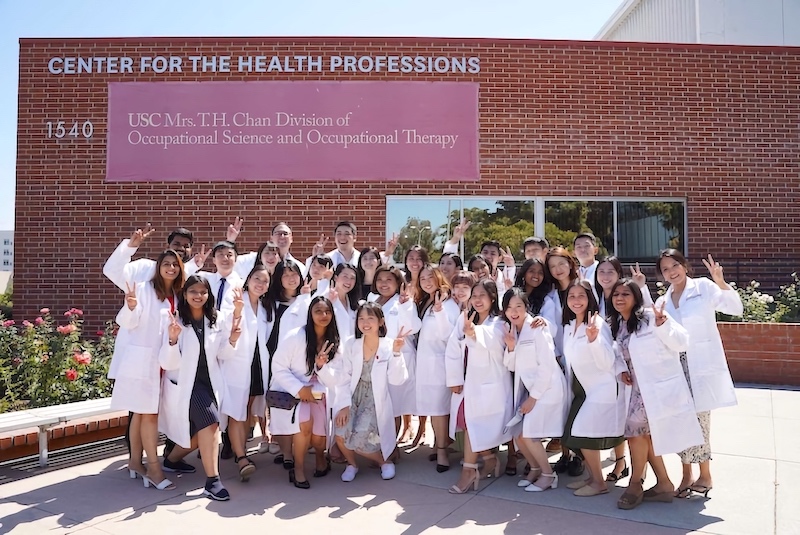
Our White Coat ceremony! Photo credits to Godfrey Lok.
⋯






